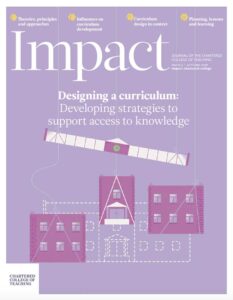A design for life – curriculum and assessment for long-term learning

The when, how and why of assessment are ultimately dependent on what is being assessed, namely the curriculum. Like many schools, we spent a lot of time redesigning Key Stage 3 assessment following the removal of National Curriculum levels. It took us a while to realise, however, that we were approaching things the wrong way round: you don’t start with assessment; you start with what you want students to learn and then you decide when and how you are going to assess the extent to which they have learned it. Our focus therefore shifted to defining what we wanted students to learn, and aligning this with when and how we were going to assess it.
What are big ideas?
At the heart of our curriculum is the principle of big ideas. Dylan Wiliam (Wiliam, 2013) describes these as ideas that ‘enable teachers and students to see the connectedness of the whole curriculum – trunk and branches if you will, rather than a disorganised collection of twigs and pine needles’. Our curriculum is designed with long-term learning in mind. We want students to take what they learn into adulthood, and for teachers to continue to grow their disciplinary and pedagogical knowledge. We have therefore developed teacher knowledge organisers, which add to the substantive content of student knowledge organisers, and provide a means for gathering together the collected wisdom of departments on how best to explain and sequence learning. There is also space for misconceptions to be collated, and for vertical and horizontal curriculum connections to be mapped out in advance and added to later on.
How are big ideas broken down?
Everything works backwards from a clear articulation of each big idea. In English, for example, figurative language is defined as the ‘departure from the standard meaning of words to achieve poetic meaning’, whereas in science, particles refer to ‘the type, arrangement and movement of atoms and the way this determines the properties of substances’. These ideas are then broken down into curriculum design principles, theories and approaches learning progressions that we expect students to achieve by the end of each year; see Figure 1 for details. Meyer and Land’s notion of threshold concepts provided us with a model of how students might develop their understanding of an idea until ‘a new and previously inaccessible way of thinking’ (Land and Meyer, 2003) is achieved.

Ongoing formative assessment
To keep a tight focus on building towards these end points, students complete a 50-item formative assessment every two weeks, with every question tied to one of the incremental steps. These steps are called atoms and are framed as questions – questions that we want students to be able to answer by the end of the year. Early items in each assessment are tied to recently taught atoms, whilst later questions re-engage students with content from previous units, thereby building in spaced retrieval across the school (Benjamin and Tullis, 2010).
This approach also means that teachers get immediate and reliable feedback on the short-term performance of their students, helping us to prioritise what to focus on next in lessons.
Thinking differently about summative assessment
Summative assessment takes the form of two termly performance tests and one end-of-year examination. Teacher workload and assessment reliabilityIn assessment, the degree to which the outcome of a particul are important considerations, which is why performance tests predominantly consist of multiple-choice questions. This format makes it possible to mark responses centrally, and to analyse the effectiveness of individual items along with the reliability of the assessment as a whole.
End-of-year assessments also include a multiple-choice component, but in addition there are extended tasks assessed using comparative judgementAn approach to marking where teachers compare two students, a form of assessment that uses direct comparison rather than absolute judgement (Pollitt, 2004). End-of-year exams are intended to provide information about changes in long-term memory. We feel that asking students in science to ‘describe the adaptations of a red blood cell’, or in maths to explain ‘why we need negative numbers’, enables them to apply what they have learned over the year whilst revealing to us the extent of their conceptual understanding.
Where we are now
It has taken years for us to get to this point, and by no means have we created a perfect model. What we have, however, is a far cry from what went before, where, like many schools, we had a varied understanding of the curriculum. The focus was very much on the ‘disorganised collection of twigs and pine needles’ described by Wiliam (2013). We believe that our curriculum now allows students to stand back and appreciate the ‘trunks and branches’ and, pushing the metaphor a little further, to be able to see the wood for the trees.










